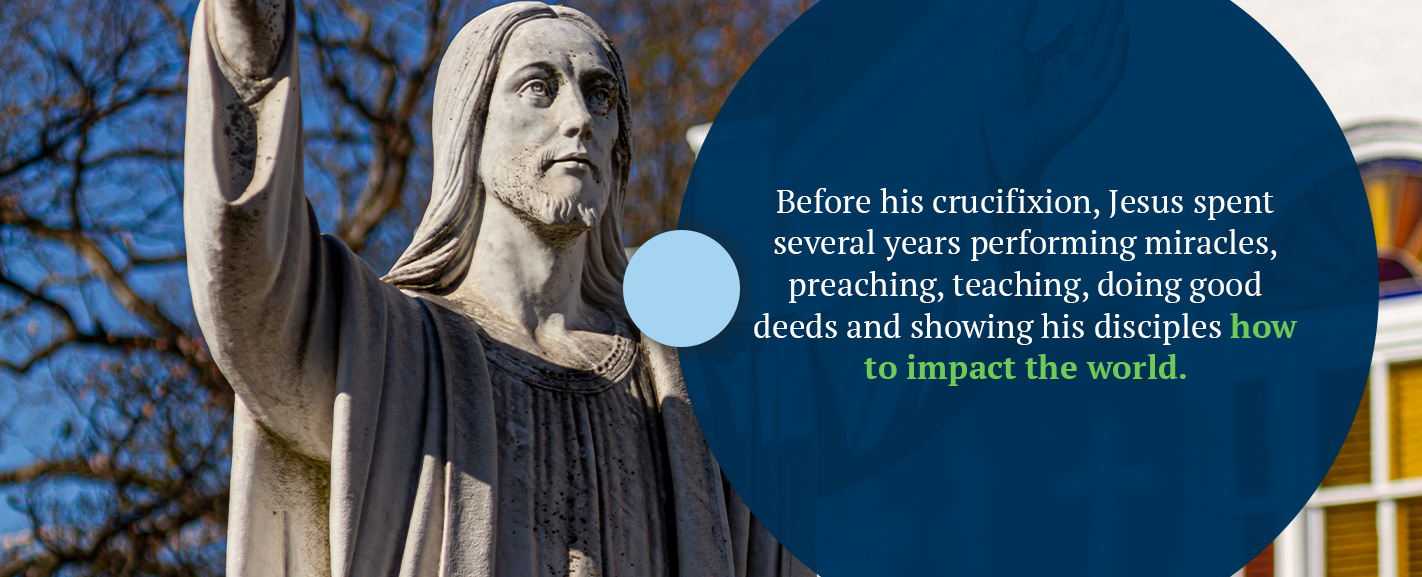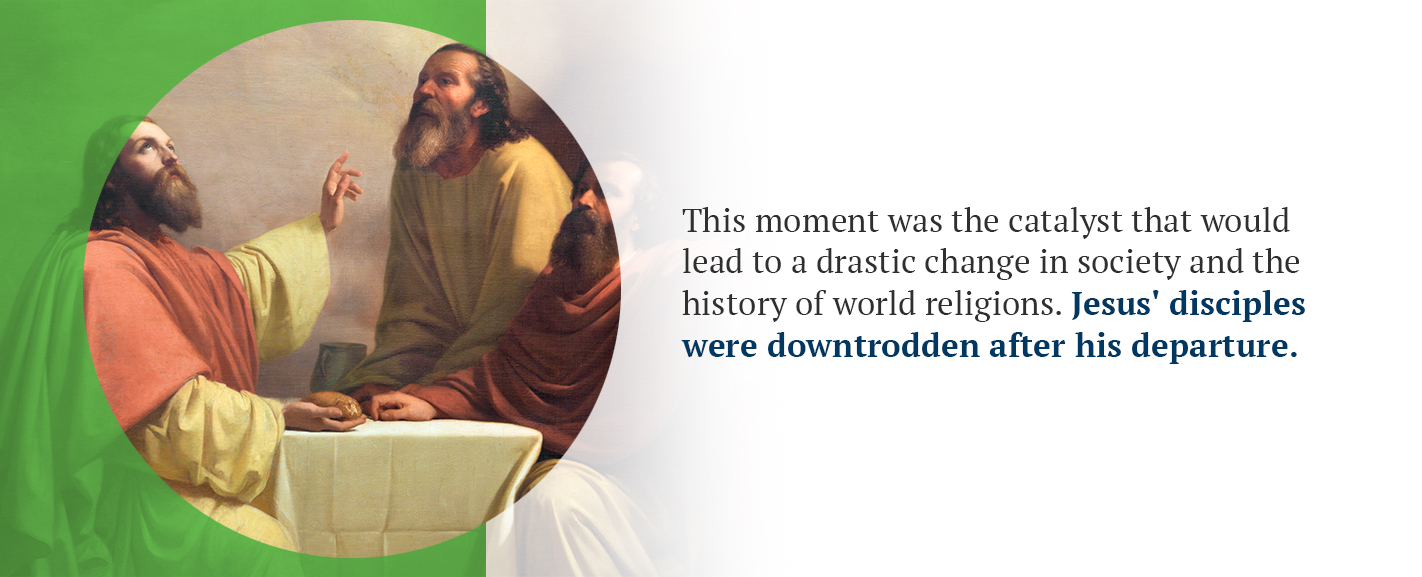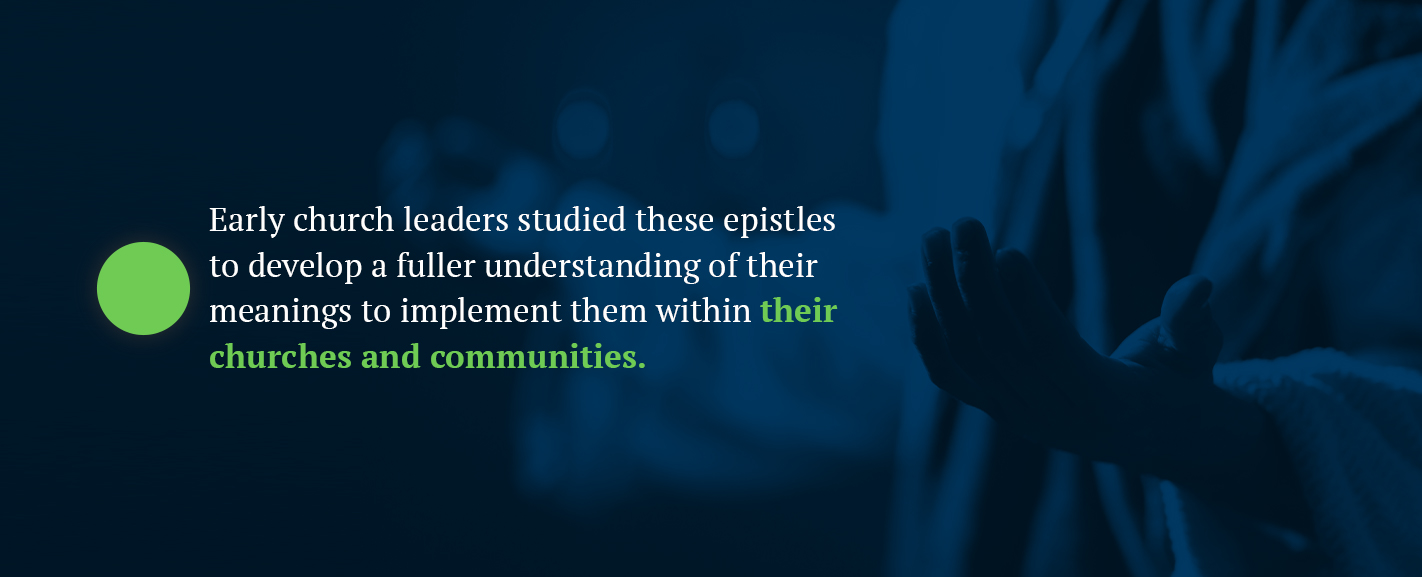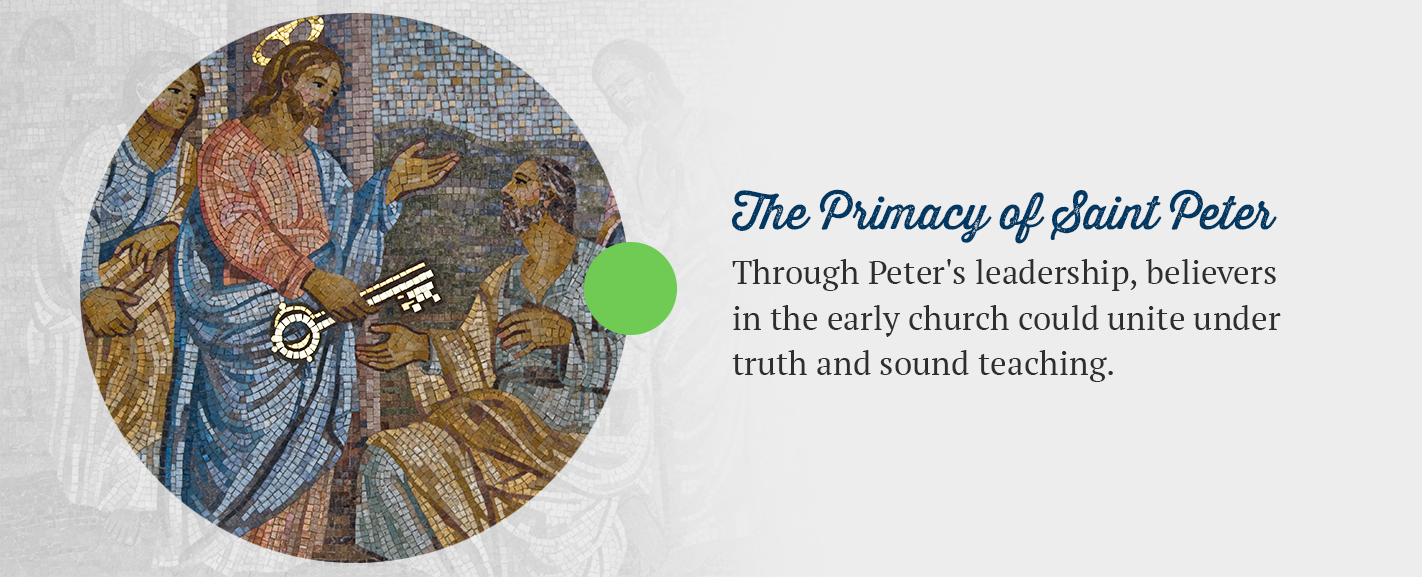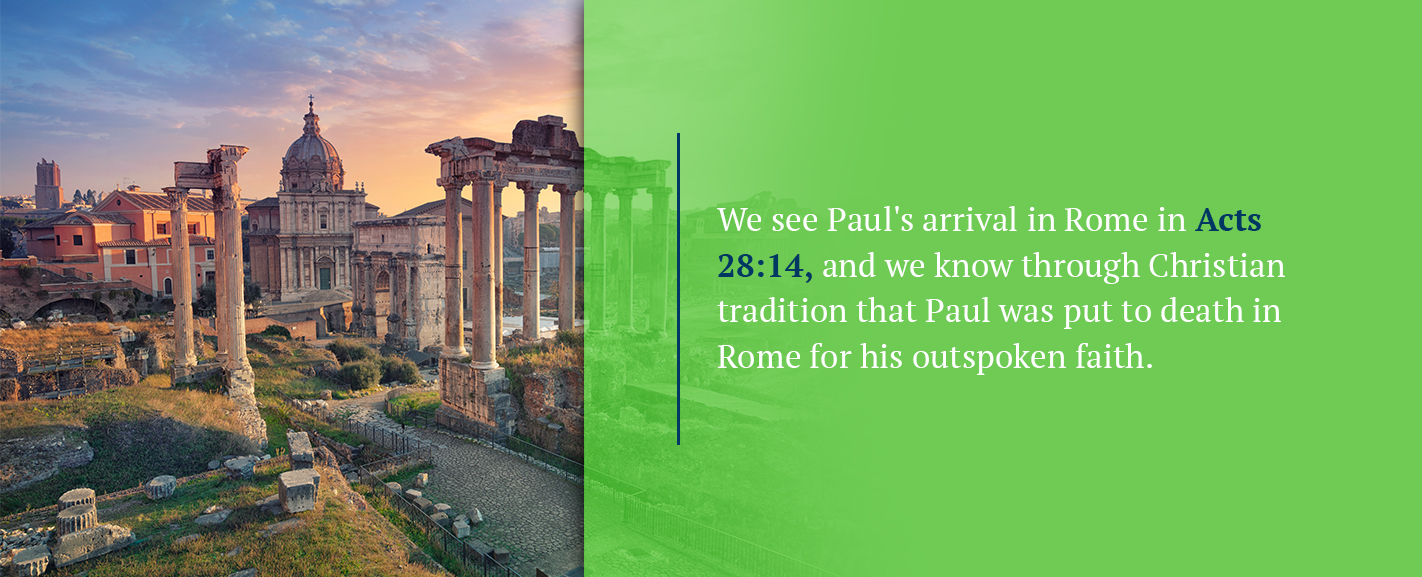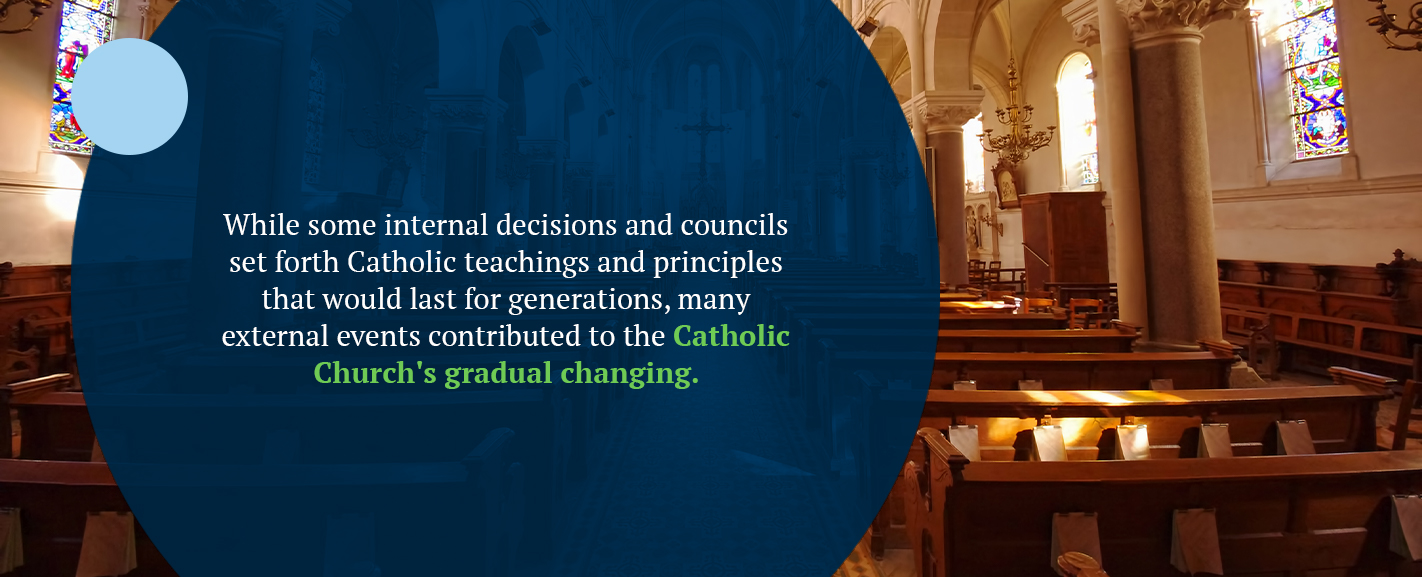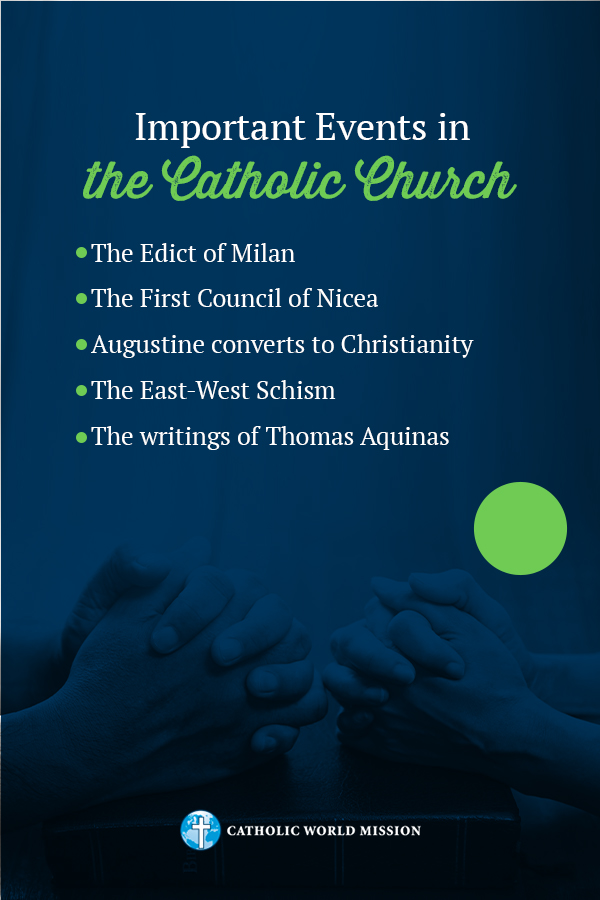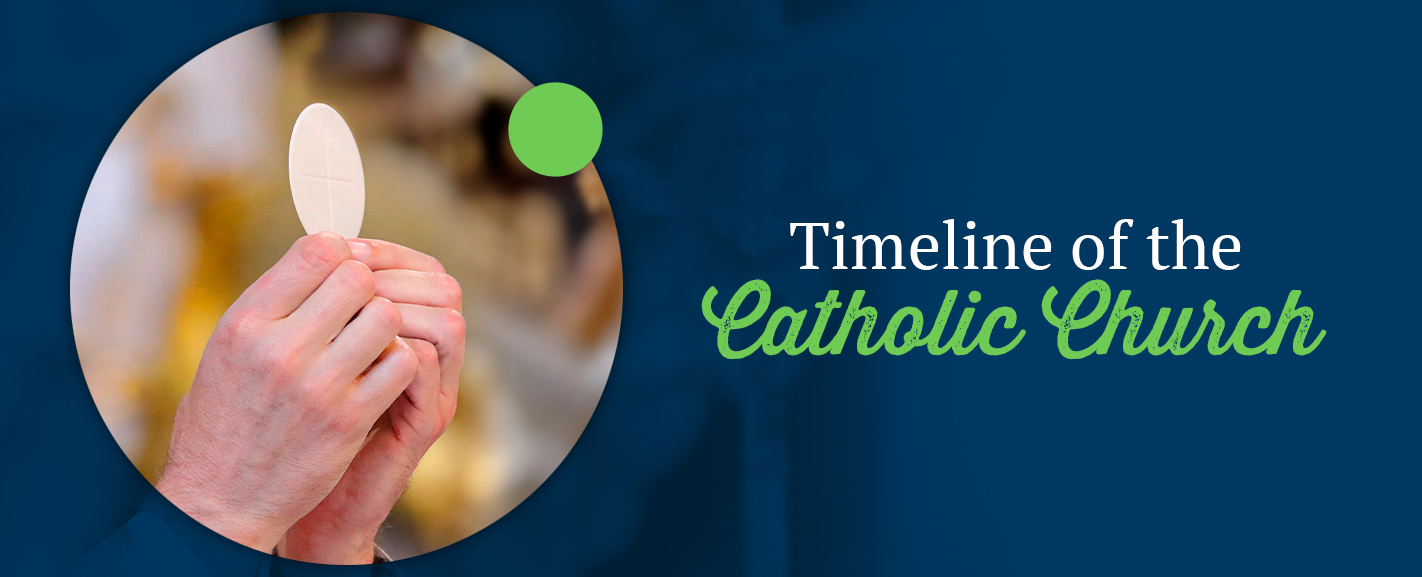
Timeline of the Catholic Church
The Catholic Church is an influential pillar of today’s global society. People around the world share the same Catholic faith despite borders and cultures. Many people in America have seen Catholic Churches in their towns or have participated in Catholic events. For generations, attending Catholic mass and sharing in the sacraments has been a cornerstone of public and family life.
Knowing the timeline of the Catholic Church’s history can help you have a deeper, richer understanding of your faith. Despite the passing generations and the comings and goings of great leaders and nations, the Catholic Church continues to be a beacon of light to a world in need.
Help Further the Mission of the Catholic Church
Jump to Section:
The History of the Catholic Church
To understand Roman Catholic Church history, you need to go back to the very beginning of this incredible movement. Catholicism may be one of the world’s most-practiced religions today, but things looked different in times past. Catholicism started as a grassroots movement of brave individuals striving to love their neighbors as themselves as Jesus taught them to. That brings us to the most fundamental part of the history of Catholicism — the life, work and resurrection of Jesus Christ on Earth.
Jesus Christ: The Founder of Catholicism
Jesus Christ founded the Roman Catholic Church during his earthly ministry around 30 A.D. Jesus shattered people’s preconceived notions of what it means to be religious and believe in God, while at the same time fulfilling ancient prophecies about the coming Messiah, and pointing people to a deeper relationship with God the Father. He changed the course of history forever in his short 33 years on the planet. Knowing that the Catholic Church begins with knowing about the life of Jesus. Let’s look at some of the major highlights of Jesus’ life and how he founded the Catholic faith:
- Jesus’ birth: Jesus’ birth, or the nativity, was the miraculous occasion that set the following events into motion. The Gospel of Luke recounts Jesus’ birth in the city of Bethlehem to the Virgin Mary, whom Catholics highly venerate to this day. Jesus was born during Herod the Great’s rule of Judea during the reign of Roman Emperor Augustus. The Gospels describe Mary’s miraculous conception of Jesus by the power of the Holy Spirit. Christians believe Jesus was born more than a man — he was born the Son of God incarnate.
- Jesus’ earthly ministry: Jesus’ life, from birth, was spent in service as God’s son. As a child, he was found teaching Jewish leaders in the temple. As an adult, he began his ministry by preaching repentance, teaching love of others, healing the sick and blind, and casting out demons in order to bring people to a meaningful life of faith and salvation. Jesus’ earthly ministry includes important events such as demonstrating the act of baptism, and the selection of his Twelve Apostles. John the Baptist baptized Jesus around 28 A.D. during Tiberius Caesar’s 15th year on the throne. From there, Jesus began his ministry by selecting the apostles who would help him in his work and carry the torch after he was gone. The apostles include Peter, James and John, who were in Jesus’ inner circle and witnessed Jesus’ many sermons, miracles and teachings.
- Peter and the apostles’ belief in Jesus as the Messiah:A pivotal moment of Catholic history is when the apostle Peter declares his belief that Jesus is the Son of God, the Messiah sent by God to save mankind from their sins. This was in fulfillment of the Jewish Scriptures as well as the predictions of the Hebrew prophets of old. Peter, whose name appears more times in the Gospels than any other apostle, was the leader and spokesman of Jesus’ disciples, which makes his statement of Jesus’ divinity even more substantial.
- Jesus’ betrayal, trial and crucifixion:In 30 A.D., Jesus’ final and most important events on Earth begin to unfold. Jesus makes his triumphal entry into Jerusalem, where the people greeted him with great praise. But, Jesus’ own disciple Judas betrayed him and handed him over to the authorities to be tried on charges of blasphemy. Pontius Pilate, the procurator of Judea during the reigns of Herod Antipas and Tiberius, found Jesus guilty and sentenced him to death by crucifixion.
- Christ’s resurrection and ascension into heaven: Three days after Jesus’ death and burial, his followers reported seeing him risen from the dead. Forty days later, Jesus gave the Great Commission to the apostles. Found in Matthew 28:19-20, Jesus’ Great Commission tells his disciples to go throughout the world, preaching the gospel and teaching people to observe his commands. Then, before ascending into heaven, Jesus promises to be with his disciples for all time.
It was this Great Commission that would launch the apostles on their world-changing mission of spreading the good news of Jesus. This would give birth to the Christian religion, and eventually, the Catholic faith as people observe it today.
The Acts of the Apostles
This moment was the catalyst that would lead to a drastic change in society and the history of world religions. Jesus’ disciples were downtrodden after his departure. No more could they rely on Jesus to perform miracles and preach sermons. Jesus left the task of spreading his teachings around the world to his disciples, and they had their work cut out for them. The book of Acts picks up at this moment. After some deliberation, the disciples put their newfound calling into motion.
These early acts of the apostles — which is where the book of Acts gets its name — are what shaped the early Christian church, giving some glimpses at what it would become hundreds and even thousands of years from then. One can see that many branches of Christianity exist today. The book of Acts details how the teachings of Christianity can change lives, but it also shows that the rapid spreading of teachings could lead to different interpretations and practices. This would lead to the official establishment of Roman Catholicism.
The Epistles of the New Testament and the Need for Standards of Truth
The epistles that follow the book of Acts take a deeper look into the theology of Christianity. Paul, Peter and John were the primary writers of these epistles, and they lay out the foundational doctrines of Christianity and Roman Catholicism. Early church leaders studied these epistles to develop a fuller understanding of their meanings and implement them within their churches and communities. The studying of these doctrines and their implementation into belief systems are the first signs of Catholicism.
Early Christians were pluralistic in their beliefs. Early believers needed to defend the truth and establish a set belief system. In I Timothy 6:20, Paul admonishes Timothy, a young Christian church leader, to, “…guard what has been entrusted to you. Avoid profane babbling and the absurdities of so-called knowledge.” This verse shows that false teaching was spreading during those early years of Christianity, and Paul left the task of defending the truth to Timothy. Early churches needed sound authority to keep them from absorbing falsehoods.
Saint Paul also changed the concept of the church in Ephesians 1:23 when he refers to the church as Jesus’, “…body, the fullness of the one who fills all things in every way.” This unique phrasing shows that the church needs unity as the body of Christ in the world. A unified church can complete the mission given by Jesus to “make disciples of all nations” in a way that a fractured religion cannot.
When Did the Catholic Church Start?
Early Christianity continued to grow its roots throughout the world as the church fathers shared their teachings far and wide. But at this point in history, Catholicism had yet to separate itself from other forms of Christianity. Two truths needed to occur to mark the start of Roman Catholicism. These events are the following:
- The primacy of Saint Peter above the other disciples
- The primacy of Rome as the center of Catholicism
We’ll take a closer look at these two events and how together they signal the founding of the Roman Catholic Church.
The Primacy of Saint Peter and the Establishment of Papal Authority
Jesus set Peter apart from the other disciples during his earthly ministry around A.D. 30, declaring his primacy in the establishment of the Catholic Church after Jesus would leave them. Many modern Bible scholars believe Jesus knew of the need for church unity and specific leadership before leaving his disciples, leading to what he says to Peter in Matthew 16:18, “Upon this rock I will build my church.” Peter’s name means “stone” — a name that Jesus gave to Peter when he met him.
Roman Catholic tradition views this verse as Jesus’ formation of the papacy, making Saint Peter the first pope and establishing the Roman Catholic Church in the same moment. Through Peter’s leadership, believers in the early church could unite under truth and sound teaching. Here are some examples of the type of leadership Jesus expected of Peter and continues to expect of every pope that has come after him:
- To strengthen the entire church:In Luke 22:32, Jesus says to Peter, “I have prayed that your own faith may not fail; and once you have turned back, you must strengthen your brothers.” In establishing the Roman Catholic Church and the papacy, Jesus commanded Peter and every pope thereafter to strengthen the members of the Catholic faith.
- To guide and care for the church: The pope must guide the church like a shepherd tending their flock. Jesus referred to himself as the Good Shepherd and the church as his sheep in John 10:11. A crucial part of the history of the Catholic Church timeline is Jesus’ departure from Earth. Before his ascension, Jesus passed on the earthly care of his sheep to Peter, the pope of the Roman Catholic Church. In John 21:15-17, Jesus tells Peter to “Feed my lambs,” “Tend my sheep,” and “Feed my sheep.”
The establishment of the papacy is a key moment for the formation of the Catholic Church. Though this moment is only one side of the coin. The other is Peter’s connection to the church of Rome.
The Primacy of the City of Rome
The New Testament lacks outright evidence of the primacy of the city of Rome to the Catholic faith. We see Paul’s arrival in Rome in Acts 28:14, and we know through Christian tradition that Paul was put to death in Rome for his outspoken faith. Yet Paul’s epistle to the Romans lacks any mention of Peter during his greeting. We do get a hint at Peter’s connection to Rome in his own two epistles in the New Testament.
In I Peter 5:13, Peter refers to a supposed congregation of believers as the, “chosen one at Babylon.” Many Bible scholars and historians attribute this phrase as a codeword to describe the church of Rome. It’s also worth noting that Peter addresses his epistles to a general audience, unlike many of Paul’s epistles, in which he addresses his letters to a specific body of believers or individuals. This hints that Peter wrote his epistles to be authoritative to the entire Catholic Church, like other papal addresses throughout history.
More than that, unanimous Christian tradition states that Peter met his end at the hands of the Roman government in the city of Rome itself. Peter’s journey took him first to Jerusalem and then to Antioch, but the final location of his journey was Rome, where he was crucified upside-down to show deference to Christ’s crucifixion. Peter, as the first pope, was martyred in Rome, the capital of the Roman Empire. These facts alone point at least to the major significance of Rome in the Catholic tradition.
Many historians point to Rome’s significance as the capital of the Roman Empire as reason enough for it to be the center of Catholicism during these formative years for Catholicism. As the most prominent city in the empire, it stands to reason the church of Rome should also be the most prominent church in the world as Christianity and Catholicism spread. By the time of Peter’s death around A.D. 64, Rome had established itself as the cornerstone of Catholicism.
Important Events in the Catholic Church
While some internal decisions and councils set forth Catholic teachings and principles that would last for generations, many external events contributed to the Catholic Church’s gradual changing. Here are some events that helped shape Catholicism into a dominant world religion and spiritual authority:
The Conversion of Emperor Constantine in A.D. 312
The conversion of Emperor Constantine in A.D. 312 is by far one of the most important moments in the history of the Roman Catholic Church. After his conversion, Constantine legalized Christianity in society. Plus, he promoted the interests of Christianity and assumed an active role in its doctrinal and institutional development. These actions made Emperor Constantine one of the leaders responsible for the spread of Roman Catholicism throughout the world.
Each subsequent emperor except Julian the Apostate ascribed to the Christian faith. Theodosius I even made Catholicism the official religion of the entire empire in A.D. 381. Catholicism experienced much change over the decades and centuries as emperors and rulers associated themselves with Catholicism, its doctrines and its implementation throughout the empire. Catholicism grew in power and influence during these years.
The Collapse of Western Governmental and Administrative Structures During the Fifth Century
Another catalyst for the changing of the Catholic Church was the collapse of governmental and administrative entities in the Western Roman Empire in the fifth century. During this time, Germanic tribes and other ethnic groups migrated to Europe and established themselves as rulers of the land. Many of these groups adopted Christianity, but the Roman Catholic Church viewed some of these groups as heretical in their doctrine, further establishing Roman Catholicism and the pope as the benchmark for Christian truths.
As Rome began waning in political power from the arrival of these other people groups, the pope grew in spiritual power, influencing the course of history in Europe and Western civilization. Tribes and nations began to acknowledge the pope’s power in world affairs, causing more people to accept Catholic teachings. The fact that most Roman Emperors during this time aligned themselves with Christianity was one of the main ways that the Catholic Church spread during the Middle Ages.
The Rise of Islam in the Seventh Century
The Middle Ages saw Catholicism’s association with Rome develop into one of its signature characteristics. One of the main reasons for this was the rise of Islam during the seventh century. In the decade following the Prophet Muhammad’s death in A.D. 632, many of his followers captured three of the five patriarchates, or influential cities, of the early church. These were Jerusalem, Alexandria and Antioch.
This event left only Rome and Constantinople as vital hubs of the Catholic faith, each on opposite ends of the Mediterranean. This splitting of Catholicism between Rome and Constantinople would have much more significant consequences than anyone would have guessed during these events in the seventh century.
Other Important Events
With such a rich and storied history, the Roman Catholic Church has experienced countless major events that have shaped the trajectory of the church and the entire world. The important events of the Catholic Church could fill textbooks, but in this section, we’ll take a look at a few of them to give you a fuller understanding of the significance of the Roman Catholic Church timeline. Here are a few more important events of the real history of the Catholic Church:
- The Edict of Milan: Emperor Constantine’s conversion was one of the catalysts that led to the pivotal Edict of Milan in A.D. 313. This edict legalized Christianity, raising it to the same level of social acceptance as other religions of the time. This moment marked the Roman Empire’s first abandonment of its Christian persecution policies that had lasted since the time of Jesus. The age of the martyrs had ended, and a new age of Rome being a Catholic empire had begun.
- The First Council of Nicea: As Catholicism grew throughout the Roman Empire, divisions within the church began to arise as in the early days of Christianity. The source of this division was a disagreement within churches of who Jesus Christ was and is. Emperor Constantine called together church leaders, assembling the First Council of Nicea in A.D. 325. Their conclusion of the equal godhood and manhood of Jesus Christ proved foundational to the Catholic faith for the rest of time.
- Augustine converts to Christianity: Augustine’s conversion to Christianity in A.D. 386 would become a turning point in Catholic history. Bible scholars and historians view Augustine’s theological writings as timeless, for they contain explanations of pivotal doctrines that the Catholic Church continues to embrace. Such teachings include the necessity for the Catholic Church to exist unified as one body. He also explained the power of Communion and baptisms did not come from priests, but from God himself. Augustine fought heresies throughout his life, clarifying the proper teachings of Catholicism.
- The East-West Schism: As mentioned, the East-West Schism, or the Schism of 1054, was one of the most pivotal moments in Christian history. The leaders of both factions were unable to reconcile the differences in practice between the Western Church and the Eastern Church, causing their definitive split into Roman Catholicism and Eastern Orthodoxy. Both churches would continue to thrive, but their existence as two separate sects of Christianity remains to this day.
- The writings of Thomas Aquinas: Many within the Catholic faith consider Thomas Aquinas to be one of the most influential writers and thinkers in all of Christianity. He wrote several notable works during the 13th century that outlined Christian doctrines and gave instructions on how to be a missionary. Today, theologians study the writings of Thomas Aquinas much like a writer would read and study the works of Shakespeare. Both Catholic and Protestant Christians hold Thomas Aquinas’s writings as essential explanations of core doctrines.
How Has the Catholic Church Changed Over Time?
As you can see from the history of the Catholic Church, a lot has changed since its humble beginnings. What started as one man — Jesus Christ — and his Twelve Disciples has grown into one of the leading religions in the world. Statistics from the Pew Research Center reveal that nearly 1/3 of the world’s population practices some form of Christianity, Catholicism being one of the leading sects.
Despite its incredible increase in worldwide followers, the heart of Catholicism remains the same. Jesus Christ gave the two greatest commandments in Matthew 22:37-39. The first is to love God with all your soul, heart, strength and mind. The second is to love your neighbor as yourself — the Golden Rule, as many refer to it today.
These two instructions have been at the center of Catholicism throughout its history, and Catholics continue to follow those commands today. The spirit of these commands is what leads people around the world to donate to Catholic charities, investing in the physical and spiritual well-being of people they have never met.
Continue the Catholic Tradition of Charity by Partnering With Catholic World Mission
Jesus gave the ultimate example of humility and servanthood. The apostles spread the message. Since then, the Catholic Church has grown into a major societal force, helping people experience spiritual and even physical freedom. Now you can share in this rich history by partnering with us in helping people in need around the world.
We are independent of the Catholic Church, but we adhere to its teachings and believe it can change lives for the better. When we partner with an area in need, we do more than hand out meals — we come alongside the community, partnering with them so their hard work can lead to true, long-term self sufficiency. As Pope Francis said, “Charity that leaves the poor person as he is, is not sufficient. True mercy…demands that the poor find the way to be poor no longer.”
This is our goal at Catholic World Mission, and we invite you to join us. Contact us today for more information about how you can get involved, and consider donating to our cause.
Learn More About Catholic History
Join Our Mailing List

